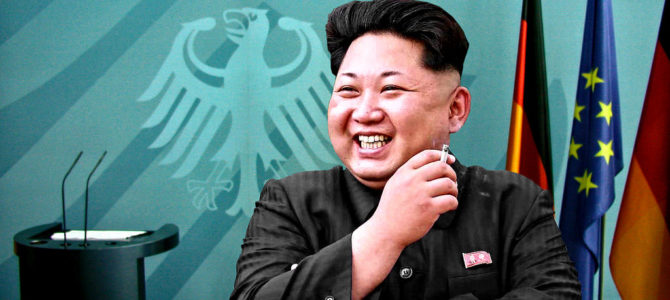
President Trump claimed a big diplomatic victory Thursday night, when he agreed to North Korean dictator Kim Jong Un’s request for a meeting.
Kim “stressed his eagerness to meet President Trump as soon as possible,” White House national security advisor Chung Eui-yong announced to reporters outside the White House. “President Trump appreciated the greeting and said he would meet Kim Jong Un by May to achieve permanent denuclearization.” Chung also said North Korea indicated it would stop testing missiles and was open to ending its nuclear weapons program.
Whether or not talks ultimately succeed, the development represents a huge success for the president’s unorthodox approach to Kim. American presidents have struggled to deal with North Korea and its ruling Kim family for decades, alternating between muted attempts at diplomacy and half-hearted saber rattling. Trump took a different tack, mixing the diplomacy and the saber rattling with a kind of gusto that his predecessors lacked, but that seems to have got through to Kim.
Unlike President Obama, Trump substantively engaged with China on the issue. Obama spent much of his two terms attempting to isolate China. This led to a more confrontational posture from the Communist country, something that caught the Obama administration by surprise, but which should have been anticipated.
These were the fruits of the so-called “Asia pivot” announced in 2011. Trump has attempted to undo some of that. He withdrew from the Trans-Pacific Partnership, which excluded China, and held a number of high level meetings with his Chinese counterpart, Xi Jinping, illustrating that the U.S. considered China a crucial partner in the Korean peace process. In response, China has applied some new pressure on the North Korean regime and has avoided challenging Trump’s rhetoric.
Upon his departure from office, Obama warned Trump that North Korea posed the sharpest short-term risk to U.S. national security in the only meeting between the two. Unfortunately for American media consumers, much of the mainstream media behaved as if President Trump’s “wild card” approach to foreign policy created this threat. That kind of coverage contributed to an inflation of the perceived threat from North Korea.
The last multilateral talks with North Korea — the so-called six-party talks that included the U.S., South Korea, China, Japan, and Russia — collapsed in 2009 after North Korea walked away, later revealing to visiting U.S. scientists a new enriched uranium facility. Kim promised to suspend nuclear talks in exchange for food aid in 2012, but missile tests have continued sporadically since then, with more frequency this year.
Nevertheless, there’s little reason not to be optimistic about direct talks. Neither Kim nor his father, who ruled from 1994 until his death in 2011, have previously offered direct talks. China is more engaged than it has been before. Trump’s insistence that U.S. allies share more of the burden for their own defense, meanwhile, has spurred South Korea, and Japan as well, to begin to increase their own military spending.
The South Koreans, too, have a new government that is more open to dialogue and eventual reunification. Earlier this week, Kim met with 10 envoys of South Korean President Moon Jae In. North Korean officials said Kim had an “openhearted talk” with the envoys and was interested in a “new history of reunification.”
Kim will meet Moon in a North-South summit planned for next month, the third of its kind and Kim’s first. Despite the media’s obsessive negative Trump coverage, it looks like there is a serious path forward ahead.
Last August, The New York Times talked to Asia “experts” who warned about the risk they said they believed such talks could pose. One former assistant secretary of state for East Asian affairs called the idea “the big trap.” A former advisor to President George W. Bush, meanwhile, dismissively suggested Trump would fall back on his “event-planning background.”
“This is not a Miss Universe pageant or a pro wrestling match, so that might stop Trump in his tracks,” Michael Green told The New York Times.
That’s silly. It’s possible for such a background to be useful here. Ultimately, a solution to the crisis on the Korean peninsula will have to come from the two Koreas and possibly their neighbors. The U.S. has long-standing security commitments that have led it to take an oversized role on the issue.
There’s an opportunity here for President Trump to create the space for the kind of managed burden-shifting that would alleviate many of the concerns Trump expressed on the campaign trail about America’s role as a force for world peace.
It’s not so preposterous to think of diplomacy as a bit like reality television. Different countries have different priorities and national security interests, but they’re operating on an international stage with an international audience, and the pressure to “get to yes” that can come with that. Trump could very well have the ability to exploit that. By taking a step forward into direct talks, the U.S. could have the chance to finally start to step back and let its partners keep their own peace.









